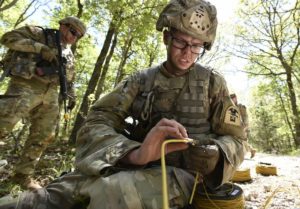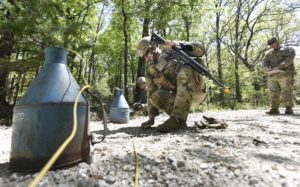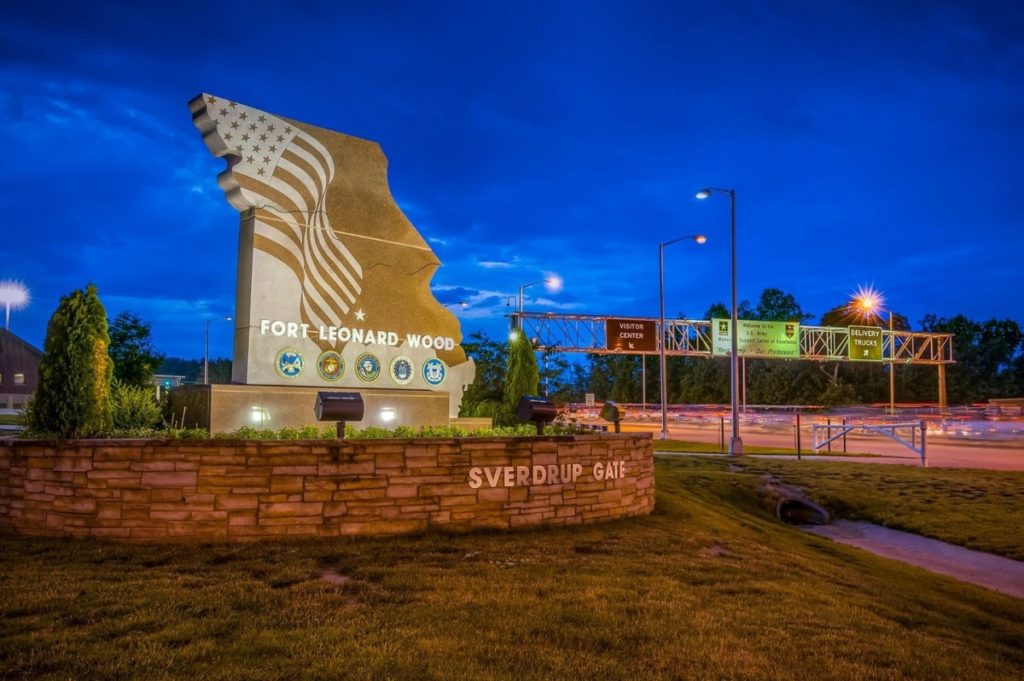Brian Hill
FORT LEONARD WOOD, Mo. (May 21, 2021) — Taking advantage of some very valuable free space on their calendar, the 35th Engineer Battalion’s Combat Engineer Skills Division held a field-training exercise May 10 through 14 for their permanent-party support personnel.
According to Sgt. Maj. Neal Feldmann, CESD chief instructor, the five-day exercise gave his team a chance to work on the engineer-skills proficiencies, warrior tasks and battle drills they don’t always have time to maintain with their normal work load instructing combat engineer and bridge crewmember Advanced Individual Training Soldiers at Range 33.
“We have a week here where we don’t have any AIT students, so we utilized it to maintain proficiencies and skills,” he said. “As far as I know, this is the first time our unit has done something like this, and I’m glad we’re able to, because some of this stuff they haven’t done since they were trainees here.”
For Cpl. Joshua Long, a bridge crew chief with the CESD’s Bridge Engineer Department, it’s a great opportunity to see what he remembers from One Station Unit Training a couple of years ago.
“We’ve all made mistakes this week, but it gives us a chance to build off those mistakes while also building unit cohesion,” said the native of Fayetteville, Arkansas.
Throughout the week, CESD support staff — along with personnel from the 35th and 31st Engineer Battalion training companies — were broken up into three squads to compete for points in events such as the Army Combat Fitness Test, M4 zero and qualification shoot, land navigation, bridge building, a 12-mile ruck march, and Sapper Stakes lanes, which included a wire-obstacle emplacement and breach, a hasty road crater emplacement and a mine-clearance operation.
Staff Sgt. Kendall Grigg, a combat engineer AIT instructor from Houston, Texas, served as one of the FTX lane supervisors. While he normally spends his days here teaching the characteristics of military demolitions, he welcomed the opportunity to get back to doing business the way he did in a U.S. Army Forces Command unit.
“It’s been about two years since I’ve had a squad underneath me, so this gives me a little refresher since I left FORSCOM,” he said. “It’s a lot of fun to get to do it again. A lot of our Soldiers came straight here from AIT, OSUT. They don’t really know how a FORSCOM unit works. Doing this training gets them out of their routine, shows them what they will see and experience when they eventually go to a different duty station — what they can expect.”
Like Grigg, Staff Sgt. Larry Elliott, from Athens, Georgia, is an AIT instructor at CESD who helped supervise the lanes during the FTX. He said he “enjoys everything” about being a combat engineer and teaching urban breach to the Army’s newest Soldiers.
“I like being the multi-tool of the Army,” he said. “I also love working with and developing Soldiers.”
Elliot said beyond just getting the experience of training like a FORSCOM unit, having exercises like these helps Soldiers develop as leaders.
“It helps our newer Soldiers build confidence in themselves, and that feeds their battle buddies as well,” he said. “It helps them see what they need to study up on to progress in the Army while making the whole team, or squad, more cohesive.”
Staff Sgt. Peter Semeatu, an explosive hazards instructor from American Samoa, added there is a huge difference between teaching and doing.
“I’m a hands-on learner,” he said. “It’s good to practice this stuff. The best way to retain it is from experience.”
At the conclusion of the FTX, Squad 2 — consisting of Sgts. Peter Kolke and Joshua Rester, Spcs. Evens Joseph and Khursandoy Togaeva, Pfc. Caleb Bladel, and Pvts. Ryan Burner, Jon Robison and Zachary Zerbe — was announced as the winner. Each squad member was presented an Army Achievement Medal by Lt. Col. Marlon Ringo, 35th Engineer Battalion commander.
Togaeva, one of the Squad 2 winners, said she hopes her unit continues to hold FTX events regularly in the future.
“With the missions this week, I was put in a leadership position,” she said. “I feel like I understand the whole picture better — it was a great learning experience.”
Originally from Uzbekistan, Togaeva immigrated with her family to Fort Myers, Florida, and joined the Army two years ago. She said she enjoys being in the minority as a female combat engineer.
“There aren’t a lot of female combat engineers, and I like being that diversity in the units I’m assigned to,” she said. “I want people to see me and say she knows what she’s doing — training like this helps.”





-30-
About Fort Leonard Wood
Fort Leonard Wood is a thriving and prosperous installation that has evolved from a small basic training post more than 75 years ago to a premier Army Center of Excellence that trains more than 80,000 military and civilians each year.
Fort Leonard Wood is home to the U.S Army Maneuver Support Center of Excellence and three U.S. Army schools: the U.S. Army Engineer School; U.S. Army Chemical, Biological, Radiological and Nuclear School; and the U.S. Army Military Police School. In addition to training engineer, CBRN and military police specialties for the Army, Fort Leonard Wood also provides gender-integrated in-processing and Basic Combat Training for new Soldiers.
Fort Leonard Wood also hosts and trains with the largest Marine Corps Detachment and Air Force Squadron on any Army installation as well as a large Navy construction detachment.
More information about Fort Leonard Wood is at: https://home.army.mil/wood/index.php/about/mission


